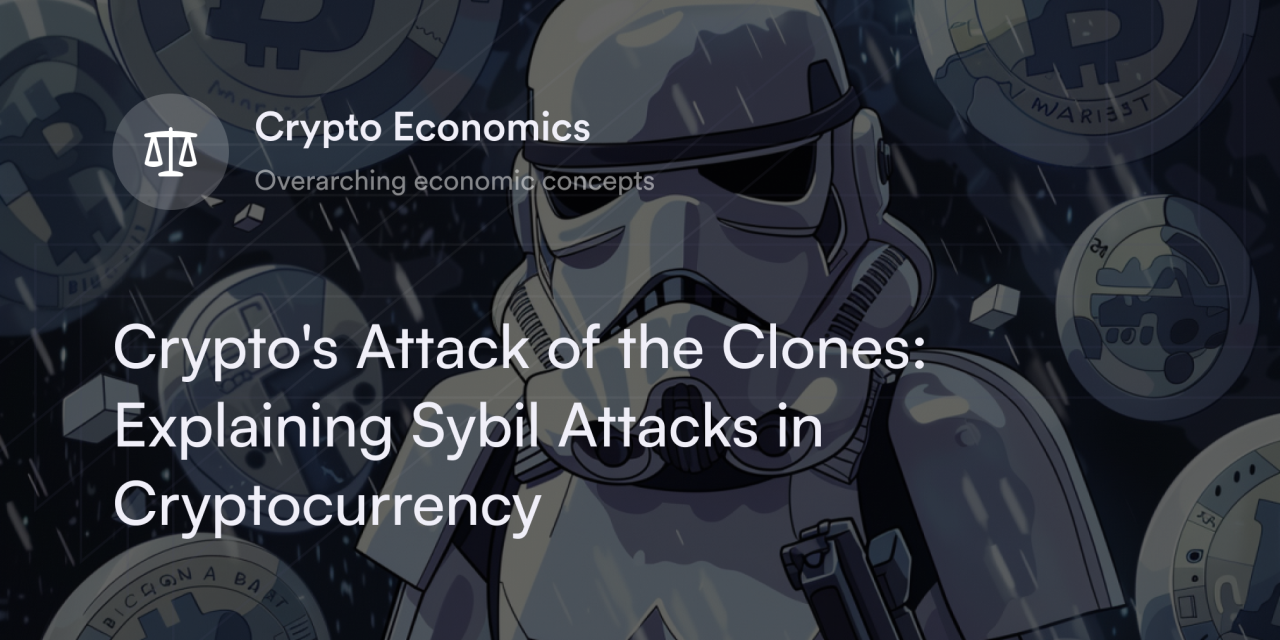


Hackers are an ever-present threat in the cryptocurrency ecosystem. Despite all the safeguards crypto developers put into decentralized protocols, bad actors sometimes find sneaky ways to exploit blockchain's permissionless nature and run away with digital funds.
Some of these attacks rely on psychological trickery and market manipulation, while others strike at the core of blockchain's peer-to-peer (P2P) infrastructure, jeopardizing cryptocurrency's entire decentralized enterprise. Sybil attacks are one such exploit that—if successfully implemented—threatens to tarnish crypto’s credibility.
Although Sybil attacks are a severe security risk, traders use many methods to minimize their likelihood. Let’s discover why these attacks are a big deal and how blockchain developers build Sybil resistance to combat them.
What are Sybil attacks?
A Sybil attack is an online security exploit where malicious actors create numerous fake identities and try to overwhelm a network. This tactic aims to get enough of a protocol's real nodes to believe the Sybil nodes are legitimate, which allows attackers to infiltrate a system and mess with transactions, consensus algorithms, or governance proposals.
Computer scientists Biran Zill and John R. Douceur first described Sybil attacks in the '90s and chose the name from a patient with dissociative identity disorder in Flora Rheta Schreiber's book "Sybil." Similar to the book’s title, the essence of a Sybil attack is that one entity embodies multiple online "personalities."
Sybil attacks are most common on P2P networks due to blockchain technology's decentralized and trustless nature. On a P2P protocol like Bitcoin (BTC), nodes interact directly with each other and use consensus mechanisms to broadcast and validate transactions. Because there's no central authority constantly screening blockchain nodes for legitimacy, stopping malicious actors from joining a permissionless blockchain before they try to disrupt the system is impossible. Although the decentralization of open-source blockchains promotes transparency and censorship resistance, it makes them more vulnerable targets for opportunistic Sybil attackers.
How do Sybil attacks work?
Sybil attacks operate by creating an atmosphere of confusion and suspicion on P2P protocols. If a Sybil attack is successful, genuine nodes on a blockchain trust information from fraudulent nodes, which gives attackers greater authority to sway a network's activities in their preferred direction.
Generally, there are two types of Sybil attacks: direct manipulation and indirect influence.
Direct Sybil attacks
In a direct Sybil attack, a malicious actor creates multiple fake identities or nodes, making each fabricated account appear independent and genuine to an online community. Once Sybil attackers gain trust in a P2P system, they use their influence to take over a blockchain's decision-making processes, often rewriting transactions, directing onchain elections, and censoring legitimate nodes.
Indirect Sybil attacks
In contrast, an indirect Sybil attack uses subtle manipulation to influence a P2P network without creating multiple fake identities. If a bad actor attempts to use this method, they focus on targeting a small number of pre-existing nodes to act as their intermediaries. After corrupting enough of these genuine nodes, the attacker uses these open communication pathways to spread false data throughout the entire ecosystem, eventually influencing the network to their advantage.
How do Sybil attacks affect cryptocurrency?
Sybil attacks are an existential threat to every decentralized digital asset. Without swift action and strong preventative measures, the effects of one successful Sybil attack have the potential to upend a blockchain's reputation and security standards. While there's no limit to what a Sybil attacker could manipulate if they break into a blockchain, a few common exploits exist in the digital assets sector:
51% attacks
A 51% attack is a severe security breach where one entity controls more than 50% of the nodes on a blockchain. If a Sybil attacker successfully tricks most of the network into believing fraudulent nodes contribute most of the energy, they can disrupt a blockchain's essential internal processes.
For example, 51% attackers often rewrite transaction data, reorganize blocks, or create copies of a cryptocurrency and spend them twice (aka double spending) to reward themselves with free virtual assets. Since all these issues destroy trust in a cryptocurrency’s payment ledger, 51% attacks devastate a blockchain's integrity.
Voter manipulation
Many Sybil-controlled identities can distort democratic voting procedures on decentralized blockchains. With enough fake nodes on a blockchain, Sybil attackers have all the votes they need to submit biased proposals and direct the decision-making process in their favor on a decentralized autonomous organization (DAO). Sybil nodes’ disproportionate influence makes votes from genuine nodes obsolete, further diminishing a chain's decentralization and democratic standards.
Pump-and-dump schemes
Crypto scammers often create multiple Sybil accounts on social media platforms to artificially drive (or pump) demand for a cryptocurrency they already hold in private wallets. This technique aims to get as many retail traders as possible to buy into a target cryptocurrency and trigger a price spike in the public market. When a cryptocurrency’s value reaches the pump-and-dump team's desired level, they simultaneously sell their holdings for a profit, leaving everyone who entered the trade during the price pump holding virtually worthless tokens.
People using pump-and-dump schemes typically target small-cap altcoins due to their relative obscurity and lower liquidity. It's also common to see these strategies play out on decentralized exchanges (DEXs) due to the greater anonymity and lack of know-your-customer (KYC) requirements.
DDoS attacks
Sometimes, Sybil attackers combine their strategy with distributed denial-of-service (DDoS) attacks to disrupt a blockchain's efficiency further. With a large enough number of fake nodes or identities, it's easier for malicious actors to bombard a blockchain with requests, making it more difficult for genuine nodes to process transactions. When successful, a DDoS attack compromises a blockchain's responsiveness and leads to network outages or service disruptions.
How do blockchains block Sybil crypto attacks?
Eliminating the potential for a Sybil attack is impossible, but blockchain developers have techniques and technologies to make these scenarios less likely. As web3 and cryptography advance, crypto projects have more tools to identify and deter malicious actors before they launch an attack.
Decentralized identity protocols
Decentralized identifiers (DIDs) and verifiable credentials (VCs) strive to bring ID data onto blockchain networks without compromising a user's privacy. Instead of storing personally identifying information in centrally controlled cloud servers, these new protocols let crypto users take ownership of tokenized versions of their credentials and store them in decentralized wallets.
For example, soulbound tokens (SBTs) are one-of-one non-fungible tokens (NFTs) issued by institutions and associated with various aspects of a user's identity (e.g., educational degrees, certifications, or credit scores). These SBTs serve as badges in a crypto user's wallet, making it easy to confirm their credentials without the threat of identity theft. Since these ID tokens are non-duplicable and non-transferrable, Sybil attackers can’t fake them in their wallets and infiltrate a blockchain.
Zero-knowledge proofs
Zero-knowledge (ZK) proof technology is an advanced cryptographic technique that allows confirming a statement’s truth without revealing the underlying information. Although ZK proofs are commonly used to batch multiple crypto transactions into ZK rollups for faster processing, they also work hand-in-hand with decentralized identity verification.
Using ZK proof protocols, crypto users and node operators have a reliable and secure way to establish their credentials without disclosing sensitive information. This privacy-preserving feature lets genuine nodes securely share their IDs onchain, making it harder for Sybil attackers to pass off fake identities as legitimate.
KYC requirements
In cryptocurrency, KYC requirements are often associated with signing up for centralized crypto exchanges (CEXs) but can deter Sybil attackers. Nodes on a KYC-enabled blockchain must submit ID documents for review before joining the transaction validation process. Although there are privacy concerns associated with this method, KYC provides a viable way to promote transparency and accountability while stopping Sybil attackers in their tracks.
Node reputation systems
Think of node reputation systems as automated report cards for validators on a blockchain's network. Cryptocurrency projects using these protocols assign trustworthiness scores to node operators over time depending on how long they've been on the network and their track record for security and participation.
Nodes with a longer history and more positive traits like active voting and accurate transaction processing receive a higher reputation score versus other nodes, giving them greater influence over the blockchain's internal processes. This weighted grading system discourages validators from misbehaving and assigns restrictions to any nodes guilty of bad conduct.
Learn more about web3 safety on dYdX Academy
Decentralization creates countless P2P opportunities for crypto traders but opens the door for new scams and security risks. Stay on top of the latest safety threats in web3 with dYdX Academy. From pump-and-dump schemes to cryptojacking, dYdX Academy has plenty of guides explaining the intricacies of blockchain security.
dYdX also offers a decentralized trading platform for eligible traders looking for a safe place to swap perpetual contracts. For more details on how qualified traders use dYdX Chain, visit dYdX's blog for the latest updates, and eligible traders can start trading on dYdX today.
Disclosures
The content of this article (the “Article”) is provided for general informational purposes only. Reference to any specific strategy, technique, product, service, or entity does not constitute an endorsement or recommendation by dYdX Trading Inc., or any affiliate, agent, or representative thereof (“dYdX”). Use of strategies, techniques, products or services referenced in this Article may involve material risks, including the risk of financial losses arising from the volatility, operational loss, or nonconsensual liquidation of digital assets. The content of this Article does not constitute, and should not be considered, construed, or relied upon as, financial advice, legal advice, tax advice, investment advice, or advice of any other nature; and the content of this Article is not an offer, solicitation or call to action to make any investment, or purchase any crypto asset, of any kind. dYdX makes no representation, assurance or guarantee as to the accuracy, completeness, timeliness, suitability, or validity of any information in this Article or any third-party website that may be linked to it. You are solely responsible for conducting independent research, performing due diligence, and/or seeking advice from a professional advisor prior to taking any financial, tax, legal, or investment action.
You may only use the dYdX Services in compliance with the dYdX Terms of Use available here, including the geographic restrictions therein.
Any applicable sponsorship in connection with this Article will be disclosed, and any reference to a sponsor in this Article is for disclosure purposes, or informational in nature, and in any event is not a call to action to make an investment, acquire a service or product, or purchase crypto assets. This Article does not offer the purchase or sale of any financial instruments or related services.
By accessing this Article and taking any action in connection with the information contained in this Article, you agree that dYdX is not responsible, directly or indirectly, for any errors, omissions, or delays related to this Article, or any damage, injury, or loss incurred in connection with use of or reliance on the content of this Article, including any specific strategy, technique, product, service, or entity that may be referenced in the Article.







